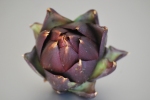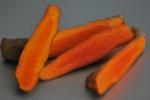If you read my last post, you will know I carried out an experiment where I asked a group of friends to smell some seasonal fruit and vegetables (blind folded) and then choose a colour (blind fold removed) from my NCS fan that best described what they could smell.
The results are interesting but not what I was expecting. I expected to see an array of Autumnal colours or at least colours that matched the highly chromatic skins of the fruit or vegetables.
Above are three representative samples from the experiment. At first glance I thought the experiment showed none other than a random set of colours which would not be totally surprising as smells are closely linked to emotions and are therefore bound to transport each person to their own unique place. However, I found an interesting pattern did actually emerge.
The first sample smell was sliced raw artichoke. The majority of colours chosen were “clean” colours as opposed to “muddied”. Colour psychologists like to group sets of colours and I favour Angela Wright‘s seasonal groupings. In this test the results all fall very neatly into a “Spring” palette.
Sample two, a sliced lime, was less successful because all my participants recognised the citrus smell and chose lemony-limey colours accordingly.
Sample three, a sliced pomegranate, resulted in several participants choosing a deep earthy brown. Interestingly, it was pomegranate seeds that Hades used to trick Persephone into eating while prisoner in the Underworld. Food and drink of course were forbidden in the Underworld so by eating the seeds, Persephone was condemned to spend six months every year back down in the Underworld. Perhaps this Greek myth is trapped somewhere in our psyche and makes us associate the smell with the deep brown of the Underworld…..
Sample four was a piece of sliced turmeric root. I found these results the most surprising of all. As turmeric is such a strong orange colour I expected warm colours to be chosen. Although all the participants chose different colours (and bear in mind they had the full 1,950 NCS colours to choose from), they all choose a “cool” colour and most of them chose some form of blue.
 Sample five was a sliced fig. Again, all the participants chose different colours but all the colours chosen were “warm” colours. It might be that the participants recognised the smell and associated eating fresh figs during warm summer holidays but nobody confessed to knowing what they were smelling.
Sample five was a sliced fig. Again, all the participants chose different colours but all the colours chosen were “warm” colours. It might be that the participants recognised the smell and associated eating fresh figs during warm summer holidays but nobody confessed to knowing what they were smelling.
What I can conclude is that we do appear to associate smells with certain colour groups even when we don’t know what it is were are smelling. However, my experiment was not particularly scientific as my sample was small and all my participants were local. In a larger group from different geographical areas, the results may change considerably.
The main thing is that it’s been fun, surprising and I’ve even gathered up some great new colour palettes some of which may well be the starting point for my next range of textiles. Result.








Its interesting how smell influence our choice of colors, or the depth of the shades of colors. Wonderful post.
LikeLike
Thank you very much for that and yes I agree colour and our emotional response is such an interesting and huge topic. I would like to take this theme a lot further.
LikeLike
This is a fascinating area and you had some interesting results. It is a huge topic especially in the area of emotional response and you could probably do a lot more experimenting. I like the fact that it is a good starting point for creativity regarding the colour palettes. Of the three samples my favourite palette is the top one, I think it’s because it seems the most balanced.
LikeLike
I agree I like the first palette too as the colours are all working really well as a group – I’m looking forward to using some actually. Thanks for your comment.
LikeLike
Very interesting post. Jealous I wasn’t a tester though. Sniff. Top quality post as always.
LikeLike
Thank you! But you are far too busy cooking these ingredients to be able to take part in my experiment! It would also be challenging for me to find ingredients that you don’t recognise by smell!
LikeLike
Much food for thought, to borrow a pun. I was especially surprised at tumeric being a deep, cool colour. I’ve never actually seen/felt/smelt tumeric in its natural state, having only come into contact with the powdered form. Now i’ll have to go hunt one down just to have a sniff!
LikeLike
Well fresh turmeric root is fairly new to me too but I’m hooked! I’ve been adding it to soups, stir fry all sorts of things in place of ginger root, plus it’s really good for you – result! The colour association was a real surprise to me too, thanks for your comment. 🙂
LikeLike
So interesting! In many of the cases, the complement was chosen. I wonder, is there some sort of correlation to “after- image” with smell?
LikeLike
Very interesting comment, thank you. Yes, that did strike me too, especially with the turmeric, I think I need to do some more work on this as there could well be some fascinating after image connections happening.
LikeLike
This is fascinating! What a fun experiment in the synesthetic qualities of color. I’d be curious to see if, after many subjects were tested, there was a correlation of color recognition to the plant – leaves, root, etc. – and not just the fruit.
LikeLike
Thanks for your comment Kelly and yes, I agree there is so much more I could do with this experiment. I would love to take it to the next stage, perhaps one day…..
LikeLike
I remember reading about your experiment, but I forgot to come back to find out the results. So interesting to see the colours people chose for the different smells. You’re right, it would be interesting to see how these results might differ with a global test group – I wonder if they’d be similar, or completely different.
LikeLike
Well I would love to do a global experiment and its probably wouldn’t be too difficult to organise. Perhaps one day….
LikeLike